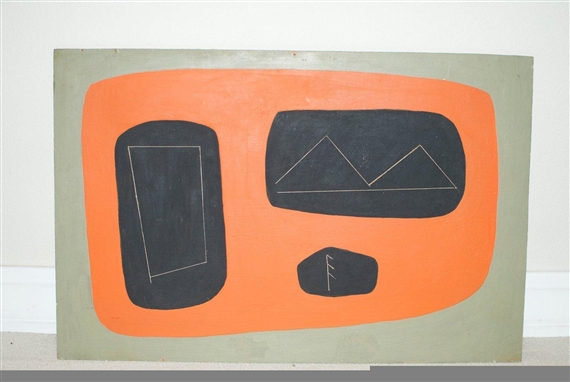Agnes Martin: Before the Grid
By 1957, Agnes Martin's work had already begun to move from biomorphic shapes with big areas of gray and black to a more linear and grid-like approach. As this new vocabulary emerged Martin grew to disdain her earlier biomorphic work, destroying as many of those canvases as possible. While most of these works were irreparably damaged, some were given to other Taos artists to reuse, most notably to Beatrice Mandelman.
The biomorphics slowly gave way in a gentle shift of intent. During the biomorphic period Martin's style was related to the work of the Taos Moderns and a few other artists living and working in New Mexico. Although Martin’s palette would stay largely consistent, the transitional paintings became what Sean Scully referred to as " the New York Grid." These transitional paintings, together with her move to New York City, led to the formation of Agnes Martin as a fully realized and mature artist.
In 1995, The Harwood Museum of Art in Taos became home to the Agnes Martin Gallery, the artist having created seven paintings for the space that she had helped design. The Harwood has long considered itself the institutional home of Agnes Martin. It is with this sentiment that the Museum will host the centennial exhibit. The exhibit will feature the rarely seen biomorphic work of Agnes Martin from 1954-1959, as well as the transitional works tracing her subtle conversion from biomorphic shapes to linear grids.
Agnes Martin: Before the Grid is made possible by the support of The Pace Gallery, The Brown Foundation, Inc. of Houston, The Robert Lehman Foundation, the Fisher Family, The Harwood Museum Alliance, John E. and Jeanne T. Hughes Charitable Foundation, Anne and Burt Kaplan in memory of Burt Kaplan, Gregory Nelson, the Peters Family Art Foundation, Mabel Dodge Luhan House, Tony Abeyta and Family, Rosamaria Ellis Clark, and La Posada de Taos.
Agnes Martin: Before the Grid is an Official Project of the New Mexico Centennial.

Recommended for you
By 1957, Agnes Martin's work had already begun to move from biomorphic shapes with big areas of gray and black to a more linear and grid-like approach. As this new vocabulary emerged Martin grew to disdain her earlier biomorphic work, destroying as many of those canvases as possible. While most of these works were irreparably damaged, some were given to other Taos artists to reuse, most notably to Beatrice Mandelman.
The biomorphics slowly gave way in a gentle shift of intent. During the biomorphic period Martin's style was related to the work of the Taos Moderns and a few other artists living and working in New Mexico. Although Martin’s palette would stay largely consistent, the transitional paintings became what Sean Scully referred to as " the New York Grid." These transitional paintings, together with her move to New York City, led to the formation of Agnes Martin as a fully realized and mature artist.
In 1995, The Harwood Museum of Art in Taos became home to the Agnes Martin Gallery, the artist having created seven paintings for the space that she had helped design. The Harwood has long considered itself the institutional home of Agnes Martin. It is with this sentiment that the Museum will host the centennial exhibit. The exhibit will feature the rarely seen biomorphic work of Agnes Martin from 1954-1959, as well as the transitional works tracing her subtle conversion from biomorphic shapes to linear grids.
Agnes Martin: Before the Grid is made possible by the support of The Pace Gallery, The Brown Foundation, Inc. of Houston, The Robert Lehman Foundation, the Fisher Family, The Harwood Museum Alliance, John E. and Jeanne T. Hughes Charitable Foundation, Anne and Burt Kaplan in memory of Burt Kaplan, Gregory Nelson, the Peters Family Art Foundation, Mabel Dodge Luhan House, Tony Abeyta and Family, Rosamaria Ellis Clark, and La Posada de Taos.
Agnes Martin: Before the Grid is an Official Project of the New Mexico Centennial.
Artists on show
Contact details


 ARTISTS
ARTISTS












